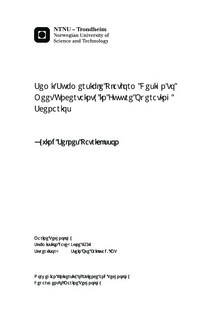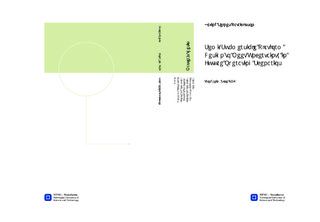| dc.description.abstract | This master thesis in marine systems design is about how to assess the future uncertainty in a design setting, or as the topic puts it; semi-submersible platform design to meet uncertainty in the future operation scenarios. Central terms that will be discussed are robustness, flexibility, adaptability, and real options, so-called ilities. Also, methods for evaluation of designs in relation to ilities and future uncertainty are presented.The background for this thesis is the ever importance of a good assessment of investment projects in the offshore business in general, and more specific in relation to designs subjected to different forms of ilities. Now, more than ever, it is crucial to make the right decisions when designing an offshore construction, to ensure that an investment is viable. This thesis has used the concept of an intervention semi, provided by Aker Solutions, to assess problems related to these aspects. At first, design drivers for the concept were identified. These were found to be cost, weigh and operability, where (total) cost and (total) weight are strictly correlated. Operability, meaning the ability to keep operations running in different conditions and situations, are mainly dependent on motion characteristics and layout, where vertical motions were found to be the most important. The properties of the intervention semi was presented as a functional breakdown, divided in five main categories; well intervention, drilling, power generation, station keeping and transit, and other functions. The last category, the one called other functions, incorporated accommodation, ballast and bilge water systems, and heave compensation system. Most relevant for the intervention concept are the intervention functions and drilling functions. Of well intervention procedures, the concept should be able to do wireline operations, coiled tubing operations, and for drilling, through tubing rotary drilling will be the main procedure. After presenting the properties for the intervention semi concept, aspects of changing requirements due to uncertainty in the future, were discussed. The design functions of changing requirements identified were operation method and technology, environment and legislation, area of operation, and economics. Following this, a discussion of how to accommodate for these changing requirements were presented, with focus on aspects regarding flexibility, robustness, adaptability, and real options. After these terms and aspects had been discussed, an evaluation of the concept in relation to the ilities presented was done. Most relevant was the possibility of a development of the coiled tubing equipment, the aspect of managed pressure drilling as a function that might be needed in the future, and the use of rental equipment. Also, ilities were identified and discussed in a concept similar to the intervention semi presented in this thesis. From this, it was found that functions related to the environment (regarding emissions) would be a potential area of ilities, due to the continually increasing focus on such matters, and by having functions related to this designed with ilities, It would make it easier to improve these functions at a later time. Also, the aspect of extra deck space was discussed, which will give the design better flexibility, and in general, it was found that flexibility in the procedures for intervention and drilling operation was important for this concept. Some functions and aspects were also found not to be relevant for any sort of ilities. Among these were functions related to heavy drilling, increased water depth and the aspect of ice class.To find the value of a design with functional ilities, different methods and aspects were presented. At first, economical aspects were discussed, and methods using net present value were found to be relevant in relation to the valuation of ilities. Another approach discussed was scenario development and assessment, where in particular one method was found relevant. This method proposes to find an optimal design for the scenario assumed most probable, and then test this design against the other possible scenarios (using the models as simulation models) to get an impression of the resilience of the designs. Two decision support models were proposed, Model 1 and Model 2. The first model presented, Model 1, can be described as a hybrid decision model, part static, part dynamic, where an optimal design is found for a set of contracts, taking real options into consideration. The contracts should reflect the future, and from a set of base designs, with varying possibilities for functions and options, a design with an optimal combination of capabilities and options will be the result of solving the problem. Model 2 is sort of a static variant of Model 1, where the possibility of real options is no longer available. The model will still find a design with an optimal combination of capabilities for a set of contracts, but all capabilities must be part of the construction initially.Further, the two models are implemented for use in a commercial solver, and parameters and constraints are discussed. These implemented models were then used for the illustrative cases.The case studies illustrate how the two models presented can be utilised, and in addition illustrate how the scenario assessment discussed earlier can be combined with the decision support models. There are mainly three cases presented; two where Model 1 is used, and a third, where Model 2 is used. In Case 1 there are three base designs, with different characteristics, and one only attribute (supplementary function) that should be assessed. Three scenarios are presented as a basis for the contract generation. First, an optimal design solution was found for each scenario (Case 1a, Case 1b and Case 1c). Secondly, a scenario assessment was done, where the solution from the scenario assumed most probable is tested against the other two scenarios using the model as a simulation model rather than an optimisation model. Scenario 1 was assumed to be the most probable one, represented by Case 1a, and the optimal solution for this case was Design 1. This design was then tested against the two other scenarios, and it came out with a rather good result, illustrating the resilience of the chosen design. Case 2 illustrated a more complex problem, where an optimal solution should be found among 16 different base designs and four possible attributes. The attributes could either be part of the design initially or made as options that can be realised at a later time. The instance tested is assumed to be somewhat more complex than a commercial problem, but illustrates in a good way the capability of Model 1. Case 3 is an example of how Model 2 can be used. In Case 3a, only one base design is available, and with a set of four possible attributes, an optimal design should be found. Due to the static character of Model 2, the attributes can only be part of the initial design. Case 3b is much the same, except here there are two base designs to choose among, in addition to the four attributesA computational study was carried out, using Model 1, and only this, as it is assumed to be the most complex of the two models. The test incident assumed most relevant, with 100 contracts, four base designs, and eight attributes, can be solved one time in on the average less than two seconds, and for a full scenario analysis, consisting of about 1000 runs, the analysis will take about half an hour.As a concluding remark for this thesis, I will say that the main scope, which I in my opinion was to discuss how different design solutions can be evaluated in relation to future uncertainty, was answered in a good way with the two decision models proposed together with how these could be used in a scenario setting. | nb_NO |

